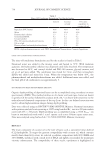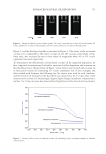715 PHYSICOCHEMICAL PROPERTIES OF TEXTURED HAIR RESULTS AND DISCUSSION The analysis of textured hair consisted of a thorough analysis by FESEM of the exterior and interior of the fibers. Examination of the interior of the fibers was made possible by a cross-sectioning technique. In addition, the lipid distribution in hair was determined by examining cross-sections of textured hair with FTIR imaging and comparing these data with those obtained for Caucasian hair. Overall, the lipid levels are relatively higher in textured hair. This led us to investigate the water management properties of textured hair with the idea that lipid composition would certainly affect water regain and subsequent loss during the drying phase of the experiment. We also investigated the tensile properties of hair, confirming that less force is required to break African hair. Examination of the fibers after break revealed that the fracture zone in the African hair cortex is distinct from Caucasian hair, while presenting a more fibrous appearance. CHARACTERISTICS OF AFRICAN HAIR One of the most striking characteristics of highly textured African hair is its geometrical configuration into a three-dimensional fiber assembly. Unlike straight hair, where the fibers are aligned parallel to each other, African hair has the tendency to form extremely tight curls that interweave with one another contributing to the optical properties, three- dimensional shape, and physical characteristics of the hair fiber assembly. Figure 1 contains a photograph of Caucasian straight dark brown hair and two types of African hair (tightly curled and extremely tightly curled) that were investigated in this study. A simple way to characterize the curl of hair is to use Equation 1 to calculate the CI, which is obtained by dividing the length of a hair fiber in the stretched configuration to the same fiber at rest: CI Length Length stretched rest = (1) Figure 1. Hair types investigated in this study: (A) Caucasian, (B) tightly curled African, and (C) extremely tightly curled African.
716 JOURNAL OF COSMETIC SCIENCE The African hair types in Figure 1B (supplied by International Hair Importers and Products, Inc.) and Figure 1C (supplied by DeMeo Brothers, Inc.) were determined to have CI values of 0.45 ± 0.08 and 0.63 ± 0.13, respectively. Closer examination of African hair reveals a number of interesting features that clearly distinguish it from Caucasian and Asian hair, regardless if comparing it to straight or curly hair. Figure 2 presents a FESEM micrograph of a section of an African hair tress (extremely tightly curled) where one can observe the complexity of the 3D fiber assembly. The clipped fibers in the image result from cuts made to isolate a small section of hair from the larger hair tress. Twists and turns in the fibers create a complex 3D fiber assembly where the fibers are interlaced together. The unique morphological structure of African hair is demonstrated in the FESEM micrograph of a single hair fiber in Figure 3. Clearly, African hair has an extremely elliptical shape along the length of the fiber. Equally interesting, we find that the large face of the African hair fiber has a concave shape. In this particular hair tress, the cuticles are abraded on the small face side of the fibers. In fact, this is a common observation we have made with extremely curly African hair. Presumably, this portion of the fiber is more susceptible to grooming damage due to its inherent morphological shape. It should be noted that a minimum of 20 fibers were examined from each hair tress. The FESEM micrographs reported in this work are representative of common features found for a particular sample set. Figure 4 presents a FESEM micrograph of another extremely tightly curled African hair fiber at its point of curvature. It can clearly be seen in the image how the fiber undergoes a twist of approximately 90° to accommodate the change in fiber orientation. Similar to the fiber shown in Figure 3, the fiber surface is also damaged, probably from repeated grooming, especially at the small face of the fiber where cuticle layers are removed. Again, note the concavity associated with the large face of the fiber. Figure 2. FESEM micrograph of a section of an African hair swatch (extremely tightly curled African hair). The cut fibers are the result of preparing a small miniature swatch from the larger swatch of hair.
Purchased for the exclusive use of nofirst nolast (unknown) From: SCC Media Library & Resource Center (library.scconline.org)






































































































































